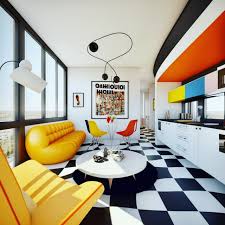Exploring the Timeless Elegance of Bauhaus Interior Design

The Timeless Elegance of Bauhaus Interior Design
The Bauhaus movement, born in Germany in the early 20th century, revolutionized the world of design and architecture. Its principles of simplicity, functionality, and minimalism continue to inspire interior designers around the globe.
Origins of Bauhaus
The Bauhaus school, founded by Walter Gropius in 1919, aimed to unite art, craft, and technology to create a new aesthetic for the modern age. Bauhaus designers believed that form should follow function and that every element of a design should serve a practical purpose.
Key Elements of Bauhaus Interior Design
Bauhaus interior design is characterized by clean lines, geometric shapes, and a focus on functionality. Neutral colors such as white, black, and gray are often used as the base palette, with bold accents in primary colors like red, blue, and yellow.
- Simplicity: Bauhaus interiors are free from unnecessary ornamentation or clutter. Furniture is sleek and streamlined, with an emphasis on practicality.
- Functionality: Every element of a Bauhaus design serves a purpose. Furniture is often multi-functional and designed for maximum efficiency.
- Geometry: Geometric shapes such as squares, rectangles, and circles are prominent in Bauhaus interiors. These shapes create a sense of order and balance in the space.
- Materials: Common materials used in Bauhaus interior design include steel, glass, concrete, and wood. These materials are often left exposed to showcase their natural beauty.
Influence on Modern Design
The impact of Bauhaus interior design can be seen in modern homes, offices, and public spaces around the world. Its emphasis on simplicity and functionality continues to resonate with designers seeking to create timeless spaces that are both beautiful and practical.
Bringing Bauhaus into Your Home
If you’re looking to incorporate Bauhaus elements into your own space, consider investing in furniture with clean lines and geometric shapes. Opt for neutral walls with pops of primary colors in your decor. Embrace minimalism and declutter your space to create a sense of calm and order.
Whether you’re a fan of modern design or simply appreciate the elegance of simplicity, Bauhaus interior design offers a timeless aesthetic that can transform any space into a work of art.
“An Introduction to Bauhaus-Style Interior Design”
“Defining Features: The Characteristics of Bauhaus Design”
4. “Bauhaus Design Essentials:
- What materials are used in Bauhaus interior design?
- What is Bauhaus-style interior design?
- What is the characteristic of Bauhaus design?
- What are the basics of Bauhaus design?
What materials are used in Bauhaus interior design?
In Bauhaus interior design, a variety of materials are utilized to achieve the movement’s signature aesthetic of simplicity and functionality. Commonly employed materials include steel, glass, concrete, and wood. These materials are often left in their natural state to showcase their inherent beauty and contribute to the overall minimalist look of Bauhaus interiors. The use of these materials not only adds a sense of industrial chic but also emphasizes the movement’s focus on clean lines, geometric shapes, and practicality in design.
What is Bauhaus-style interior design?
Bauhaus-style interior design is a modern and minimalist approach that emphasizes simplicity, functionality, and geometric shapes. Originating from the Bauhaus school in Germany in the early 20th century, this design philosophy focuses on clean lines, neutral colors, and the use of materials like steel, glass, and wood. Bauhaus-style interiors often feature furniture that is sleek and practical, with an emphasis on form following function. The aesthetic is characterized by a lack of ornamentation and clutter, creating spaces that are both visually striking and highly functional.
What is the characteristic of Bauhaus design?
The characteristic of Bauhaus design lies in its emphasis on simplicity, functionality, and minimalism. Bauhaus design principles prioritize the idea that form should follow function, with every element serving a practical purpose. Clean lines, geometric shapes, and a focus on practicality define Bauhaus interiors, often featuring a palette of neutral colors complemented by bold accents in primary hues. Materials such as steel, glass, concrete, and wood are commonly used to showcase their natural beauty. Bauhaus design continues to influence modern aesthetics with its timeless elegance and commitment to creating spaces that are both visually striking and highly functional.
What are the basics of Bauhaus design?
When exploring the basics of Bauhaus design, it is essential to understand the movement’s core principles of simplicity, functionality, and minimalism. Bauhaus design emphasizes clean lines, geometric shapes, and a harmonious balance between form and function. Neutral color palettes often serve as the foundation, complemented by bold accents in primary colors. Furniture and decor in Bauhaus style are characterized by their practicality and efficiency, with every element serving a specific purpose. By embracing geometric shapes, innovative use of materials like steel and glass, and a focus on creating timeless yet modern spaces, Bauhaus design continues to influence contemporary interior aesthetics with its enduring appeal.
